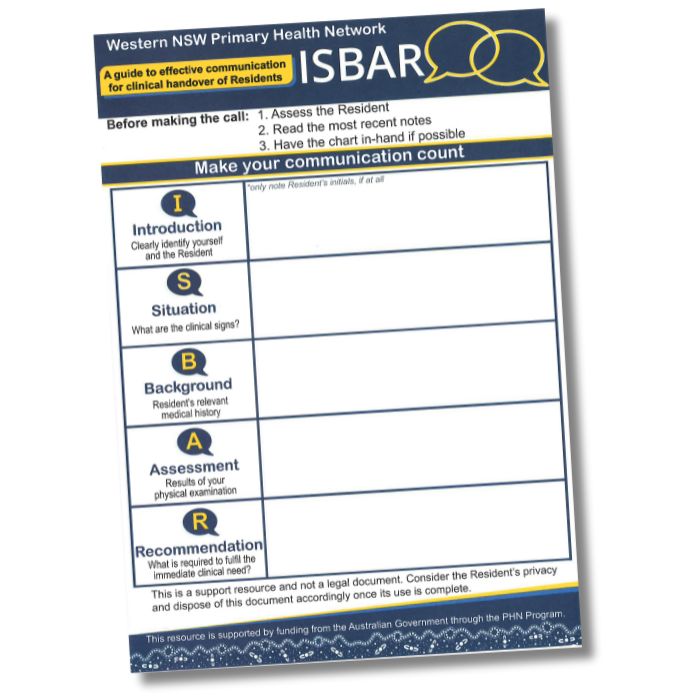ISBAR is an easy-to-remember communication mechanism for framing any critical conversation requiring a health professional’s attention and action. The tool places the individual resident at the center of care and fosters a culture of resident safety.

Introduction (Identify)
Situation
Background
Assessment
Recommendation (Request)
“The ISBAR framework, endorsed by the World Health Organization provides a standardized approach to communication which can be used in a wide range of clinical contexts” (Burgess et al. 2020 pg. 2)
- Shift changeover.
- Transfers for hospital admission, tests or appointments
- Inter hospital transfers
- Responding to deterioration
- End of life care communication
- Report writing
Preparing for ISBAR
“Nurses’ knowledge of the ISBAR was not a statistically significant factor affecting the perceived quality of handover. Rather, nurses’ understanding of patients’ care plans and receiving updated information about patients determine the perceived quality of handover.” (Pun 2023 pg.1)
Key Tips for preparing for ISBAR
- Preparation is vital, the reason for the referral being made absolutely clear
- Having written, prepared questions will assist
- It is important to gather all the patient information before handover eg. Charts, ECG, CXR
- Take notes and record any instructions
- ISBAR works best when both parties are using the same framework (Burgess et al. 2020 pg. 3)
Links to the Aged Care Quality Standards
Aged Care Quality Standard 3(e) Personal Care and Clinical Care
Information about the consumers condition, needs and preferences is documented and communicated within the organization, and with others where responsibility for care is shared.
The outcome of improving communication in the care setting is to:
- improve the safety, effectiveness and consistency of care and reduce the risk of harm
- improve the consumer’s experience of care and deliver care which reflects their choices.
What are the benefits of using ISBAR in my Aged Care Facility?
Australian research published in 2020 tells us that ISBAR works best when all parties that are involved in clinical communication are trained in using the same framework (Burgess et al. 2020)
The Goal of upskilling is to increase the quality of clinical handovers in your aged care facility.
Studies “published between 2013 and 2023 …..(9) show that ISBAR methodology, as a standardized tool for transferring nursing care in the emergency service, allows for a safe, clear, and concise transition of nursing care. The benefits relate to patient and professional safety, continuity, and quality of care, as well as patient and professional comfort, with health gains.” (Chaica et al. 2024 pg. 1)
What are the outcomes of using ISBAR as a scaffold for communication?
Short term outcome: Increase in participant’s understanding of ISBAR and the elements essential in the delivery of quality clinical communication.
Medium term outcome: Increase in the competency of clinical staff in the delivery of critical clinical communications using the ISBAR framework. Increase in the satisfaction of quality of communication between health professionals across health sectors.
Long term outcome: reduction in medication errors, reduction in hospital turn arounds, reduction in medical errors, reduction in hospital readmissions, increased compliance with advanced care directives/plans
How can aged care professionals develop critical communication skills and measure their competency?
Step 1
Learn about the ISBAR framework and how it can guide your clinical communications. To access training please email aged care.
Step 2
Become a competent communicator:
- Use the ISBAR framework to scaffold the communication.
- Practice the skills in real time or in a simulation.
- measure and track how effective you are by using the ISBAR Interprofessional Communication Rubric (IICR) (Foronda and Bauman 2024)
Research has shown that using standardized tools and participating in resident simulations is an effective way to practice the communication skills required to successfully communicate complex care information.
“Through repeated practice of communication using a standardized approach, nursing students will be better prepared to provide accurate, relevant, and efficient communications to health care providers to reduce threats to patient safety and improve patient care”(Foronda et al. 2021 pg. 41)“Simulation and use of standardized tools have demonstrated effectiveness in improving interprofessional communication skills with healthcare professionals and students” (Foronda et al. 2016 pg 40)
“Peer feedback…is particularly valuable during interprofessional clinical handover practice activities” (Burgess et al. 2020 pg. 5)
How do I order a supply of ISBAR pads for my facility?
Order copies of the free ISBAR pads here.
Page references
Burgess A, van Diggele C, C Roberts, Mellis C. Teaching clinical handover with ISBAR BMC Medical Education 2020, 20(Suppl 2):459 https://doi.org/10.1186/s12909-020-02285-0
Chaica, V.; Marques, R.; Pontífice-Sousa, P. ISBAR: A Handover Nursing Strategy in Emergency Departments, Scoping Review. Healthcare 2024, 12, 399. https://doi.org/10.3390/ healthcare12030399
Foronda, C. L., Barroso, S., Yeh, V. J.-H., Gattamorta, K. A., & Bauman, E. B. (2021, January). A rubric to measure nurse-to-physician communication: A pilot study. Clinical Simulation in Nursing, 50(C), 38- 42. https://doi.org/10.1016/j.ecns.2020.09.005
Foronda, C., & Bauman, E. (2024). ISBAR Interprofessional Communication Rubric. Retrieved from : https://www.healthysimulation.com/tools/evaluating-healthcare-simulation/the-isbar-interprofessional-communication-rubric-iicr/
Foronda, C., MacWilliams, B., & McArthur, E. (2016). Interprofessional communication in healthcare: An integrative review. Nurse Education in Practice, 19, 36-40
Francis L (2023) Jacksonville University ProQuest Dissertation & Theses, 2023. 30687679 Increasing Nurse-Provider Communication and Decreasing Hospital Admissions of Patients from a Skilled Nursing Facility: A Quality Improvement Project.
Pun J (2023) Nurses’ perceptions of the ISBAR handover protocol and its relationship to the quality of handover: A case study of bilingual nurses. Front. Psychol. 14:1021110. doi: 10.3389/fpsyg.2023.1021110

